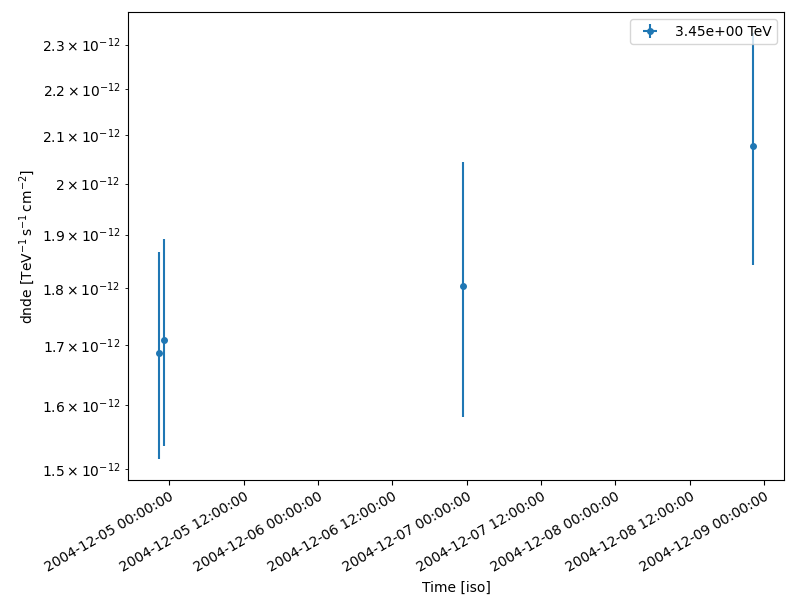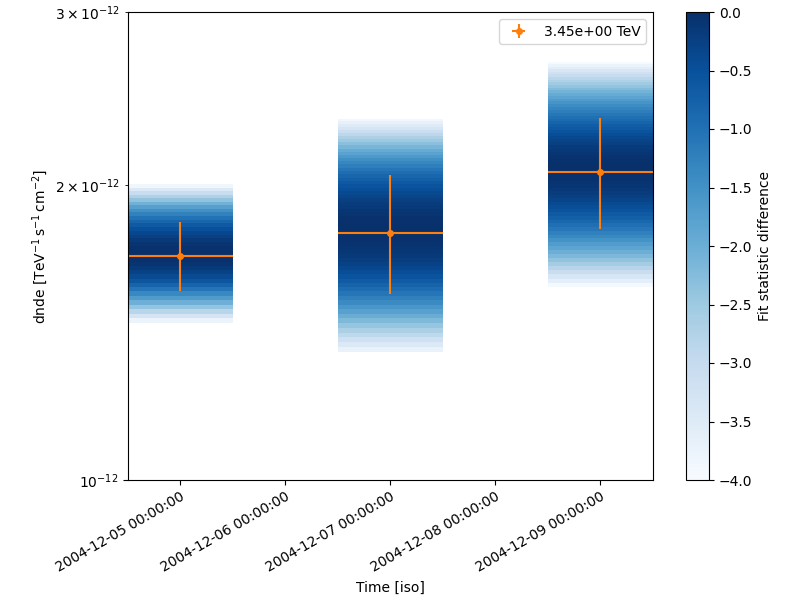Note
Go to the end to download the full example code or to run this example in your browser via Binder
Light curves#
Compute per-observation and nightly fluxes of four Crab nebula observations.
Prerequisites#
Knowledge of the high level interface to perform data reduction, see the High level interface tutorial.
Context#
This tutorial presents how light curve extraction is performed in gammapy, i.e. how to measure the flux of a source in different time bins.
Cherenkov telescopes usually work with observing runs and distribute data according to this basic time interval. A typical use case is to look for variability of a source on various time bins: observation run-wise binning, nightly, weekly etc.
Objective: The Crab nebula is not known to be variable at TeV energies, so we expect constant brightness within statistical and systematic errors. Compute per-observation and nightly fluxes of the four Crab nebula observations from the H.E.S.S. first public test data release.
Proposed approach#
We will demonstrate how to compute a light curve from 3D reduced
datasets (MapDataset) as well as 1D ON-OFF
spectral datasets (SpectrumDatasetOnOff).
The data reduction will be performed with the high level interface for
the data reduction. Then we will use the
LightCurveEstimator class, which is able to
extract a light curve independently of the dataset type.
Setup#
As usual, we’ll start with some general imports…
import logging
import astropy.units as u
from astropy.coordinates import SkyCoord
from astropy.time import Time
# %matplotlib inline
import matplotlib.pyplot as plt
from IPython.display import display
from gammapy.analysis import Analysis, AnalysisConfig
from gammapy.estimators import LightCurveEstimator
from gammapy.modeling.models import (
Models,
PointSpatialModel,
PowerLawSpectralModel,
SkyModel,
)
log = logging.getLogger(__name__)
Check setup#
from gammapy.utils.check import check_tutorials_setup
check_tutorials_setup()
System:
python_executable : /home/runner/work/gammapy-docs/gammapy-docs/gammapy/.tox/build_docs/bin/python
python_version : 3.9.18
machine : x86_64
system : Linux
Gammapy package:
version : 1.2
path : /home/runner/work/gammapy-docs/gammapy-docs/gammapy/.tox/build_docs/lib/python3.9/site-packages/gammapy
Other packages:
numpy : 1.26.4
scipy : 1.12.0
astropy : 5.2.2
regions : 0.8
click : 8.1.7
yaml : 6.0.1
IPython : 8.18.1
jupyterlab : not installed
matplotlib : 3.8.3
pandas : not installed
healpy : 1.16.6
iminuit : 2.25.2
sherpa : 4.16.0
naima : 0.10.0
emcee : 3.1.4
corner : 2.2.2
ray : 2.9.3
Gammapy environment variables:
GAMMAPY_DATA : /home/runner/work/gammapy-docs/gammapy-docs/gammapy-datasets/1.2
Analysis configuration#
For the 1D and 3D extraction, we will use the same CrabNebula configuration than in the High level interface tutorial using the high level interface of Gammapy.
From the high level interface, the data reduction for those observations is performed as follows.
Building the 3D analysis configuration#
Definition of the data selection#
Here we use the Crab runs from the H.E.S.S. DL3 data release 1.
conf_3d.observations.obs_ids = [23523, 23526, 23559, 23592]
Definition of the dataset geometry#
# We want a 3D analysis
conf_3d.datasets.type = "3d"
# We want to extract the data by observation and therefore to not stack them
conf_3d.datasets.stack = False
# Here is the WCS geometry of the Maps
conf_3d.datasets.geom.wcs.skydir = dict(
frame="icrs", lon=83.63308 * u.deg, lat=22.01450 * u.deg
)
conf_3d.datasets.geom.wcs.binsize = 0.02 * u.deg
conf_3d.datasets.geom.wcs.width = dict(width=1 * u.deg, height=1 * u.deg)
# We define a value for the IRF Maps binsize
conf_3d.datasets.geom.wcs.binsize_irf = 0.2 * u.deg
# Define energy binning for the Maps
conf_3d.datasets.geom.axes.energy = dict(min=0.7 * u.TeV, max=10 * u.TeV, nbins=5)
conf_3d.datasets.geom.axes.energy_true = dict(min=0.3 * u.TeV, max=20 * u.TeV, nbins=20)
Run the 3D data reduction#
Define the model to be used#
Here we don’t try to fit the model parameters to the whole dataset, but we use predefined values instead.
target_position = SkyCoord(ra=83.63308, dec=22.01450, unit="deg")
spatial_model = PointSpatialModel(
lon_0=target_position.ra, lat_0=target_position.dec, frame="icrs"
)
spectral_model = PowerLawSpectralModel(
index=2.702,
amplitude=4.712e-11 * u.Unit("1 / (cm2 s TeV)"),
reference=1 * u.TeV,
)
sky_model = SkyModel(
spatial_model=spatial_model, spectral_model=spectral_model, name="crab"
)
We assign them the model to be fitted to each dataset
Light Curve estimation by observation#
We can now create the light curve estimator.
We pass it the list of datasets and the name of the model component for which we want to build the light curve. In a given time bin, the only free parameter of the source is its normalization. We can optionally ask for parameters of other model components to be reoptimized during fit, that is most of the time to fit background normalization in each time bin.
If we don’t set any time interval, the
LightCurveEstimator determines the flux of
each dataset and places it at the corresponding time in the light curve.
Here one dataset equals to one observing run.
lc_maker_3d = LightCurveEstimator(
energy_edges=[1, 10] * u.TeV, source="crab", reoptimize=False
)
# Example showing how to change some parameters from the object itself
lc_maker_3d.n_sigma_ul = 3 # Number of sigma to use for upper limit computation
lc_maker_3d.selection_optional = (
"all" # Add the computation of upper limits and likelihood profile
)
lc_3d = lc_maker_3d.run(analysis_3d.datasets)
The lightcurve FluxPoints object lc_3d contains a table which we can explore.
# Example showing how to change just before plotting the threshold on the signal significance
# (points vs upper limits), even if this has no effect with this data set.
fig, ax = plt.subplots(
figsize=(8, 6),
gridspec_kw={"left": 0.16, "bottom": 0.2, "top": 0.98, "right": 0.98},
)
lc_3d.sqrt_ts_threshold_ul = 5
lc_3d.plot(ax=ax, axis_name="time")
plt.show()
table = lc_3d.to_table(format="lightcurve", sed_type="flux")
display(table["time_min", "time_max", "e_min", "e_max", "flux", "flux_err"])

time_min time_max ... flux_err
... 1 / (cm2 s)
------------------ ----------------- ... ----------------------
53343.92234009259 53343.94186555556 ... 2.1193777560333226e-12
53343.95421509259 53343.97369425926 ... 2.140779935183259e-12
53345.96198129629 53345.98149518518 ... 2.7872234642813915e-12
53347.913196574074 53347.93271046296 ... 2.912868843587422e-12
Running the light curve extraction in 1D#
Building the 1D analysis configuration#
Definition of the data selection#
Here we use the Crab runs from the H.E.S.S. DL3 data release 1
conf_1d.observations.obs_ids = [23523, 23526, 23559, 23592]
Definition of the dataset geometry#
# We want a 1D analysis
conf_1d.datasets.type = "1d"
# We want to extract the data by observation and therefore to not stack them
conf_1d.datasets.stack = False
# Here we define the ON region and make sure that PSF leakage is corrected
conf_1d.datasets.on_region = dict(
frame="icrs",
lon=83.63308 * u.deg,
lat=22.01450 * u.deg,
radius=0.1 * u.deg,
)
conf_1d.datasets.containment_correction = True
# Finally we define the energy binning for the spectra
conf_1d.datasets.geom.axes.energy = dict(min=0.7 * u.TeV, max=10 * u.TeV, nbins=5)
conf_1d.datasets.geom.axes.energy_true = dict(min=0.3 * u.TeV, max=20 * u.TeV, nbins=20)
Run the 1D data reduction#
Define the model to be used#
Here we don’t try to fit the model parameters to the whole dataset, but we use predefined values instead.
target_position = SkyCoord(ra=83.63308, dec=22.01450, unit="deg")
spectral_model = PowerLawSpectralModel(
index=2.702,
amplitude=4.712e-11 * u.Unit("1 / (cm2 s TeV)"),
reference=1 * u.TeV,
)
sky_model = SkyModel(spectral_model=spectral_model, name="crab")
We assign the model to be fitted to each dataset. We can use the same
SkyModel as before.
Extracting the light curve#
lc_maker_1d = LightCurveEstimator(
energy_edges=[1, 10] * u.TeV, source="crab", reoptimize=False
)
lc_1d = lc_maker_1d.run(analysis_1d.datasets)
print(lc_1d.geom.axes.names)
display(lc_1d.to_table(sed_type="flux", format="lightcurve"))
['energy', 'time']
time_min time_max e_ref ... counts success
TeV ...
------------------ ----------------- ------------------ ... ----------- -------
53343.92234009259 53343.94186555556 3.4517490659800822 ... nan .. nan True
53343.95421509259 53343.97369425926 3.4517490659800822 ... nan .. 71.0 True
53345.96198129629 53345.98149518518 3.4517490659800822 ... 51.0 .. nan True
53347.913196574074 53347.93271046296 3.4517490659800822 ... nan .. nan True
Compare results#
Finally we compare the result for the 1D and 3D lightcurve in a single figure:
fig, ax = plt.subplots(
figsize=(8, 6),
gridspec_kw={"left": 0.16, "bottom": 0.2, "top": 0.98, "right": 0.98},
)
lc_1d.plot(ax=ax, marker="o", label="1D")
lc_3d.plot(ax=ax, marker="o", label="3D")
plt.legend()
plt.show()

Night-wise LC estimation#
Here we want to extract a night curve per night. We define the time intervals that cover the three nights.
time_intervals = [
Time([53343.5, 53344.5], format="mjd", scale="utc"),
Time([53345.5, 53346.5], format="mjd", scale="utc"),
Time([53347.5, 53348.5], format="mjd", scale="utc"),
]
To compute the LC on the time intervals defined above, we pass the
LightCurveEstimator the list of time intervals.
Internally, datasets are grouped per time interval and a flux extraction is performed for each group.
lc_maker_1d = LightCurveEstimator(
energy_edges=[1, 10] * u.TeV,
time_intervals=time_intervals,
source="crab",
reoptimize=False,
selection_optional="all",
)
nightwise_lc = lc_maker_1d.run(analysis_1d.datasets)
fig, ax = plt.subplots(
figsize=(8, 6),
gridspec_kw={"left": 0.16, "bottom": 0.2, "top": 0.98, "right": 0.98},
)
nightwise_lc.plot(ax=ax, color="tab:orange")
nightwise_lc.plot_ts_profiles(ax=ax)
ax.set_ylim(1e-12, 3e-12)
plt.show()

What next?#
When sources are bright enough to look for variability at small time scales, the per-observation time binning is no longer relevant. One can easily extend the light curve estimation approach presented above to any time binning. This is demonstrated in the Light curves for flares tutorial. which shows the extraction of the lightcurve of an AGN flare.